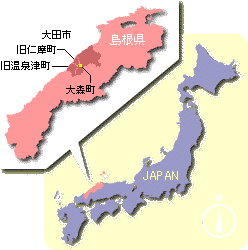|
|
www.shejapan.com > World Heritages > Iwami Ginzan Silver Mine and its Cultural Landscape.
Quiz:
|
|
|
|
日本で最も新しい世界遺産であり、安土桃山時代、江戸時代と多くの人々がこの石見銀山から生まれてくる銀を求めて戦った事や、石見銀山から生まれる銀の量は17世紀前半の世界産出量の約3分の1を占めていたと言う事を知り興味を持ちました。そして島根県大田市には今でも石見銀山を守るために作られた城や商人の家等が残っており、石見銀山だけではなくその周辺の城や町並みが世界遺産に認定された事を知り、より深く調べてみたいと思うようになりました。 赤井義人
|
Pre-reading Questions: 1. What country is Iwami Ginzan in? |

Brief
description:
The
Iwami Ginzan Silver Mine, south-west of  silver ore to the coast, and port towns from where it was shipped
to
silver ore to the coast, and port towns from where it was shipped
to

|
Reading Passage Mine history |
It was developed in
1526 by Kamiya Jutei a Japanese merchant. It reached its peak production of
38 tons in the early 17th century of approximately 38 tons of silver a year
 which was then a third of world production. Silver from the mine was used
widely for coins. It was contested fiercely by warlords until the Tokugawa Shogunate won control of it in 1600 as a result of the Battle of Sekigahara
in 1600. It was later secured by fences and barricaded by pine trees.
which was then a third of world production. Silver from the mine was used
widely for coins. It was contested fiercely by warlords until the Tokugawa Shogunate won control of it in 1600 as a result of the Battle of Sekigahara
in 1600. It was later secured by fences and barricaded by pine trees.
The property extends to 442 ha and the buffer zone 3,221 ha.




Tomogaura
鞆ヶ浦(仁摩町)16世紀前半から中ごろにかけて銀。銀鉱石を博多に積み出した港。
Okidomari(沖泊)
主に16世紀後半の約40年間、銀の輸送や、石見銀山への物資補給、軍事基地として機能した港。
Yunotsu (温泉津)
石見銀山の外港として発展した温泉のある港町。
Kamiya Juteit
石見銀山を本格的に開発したのは博多の商人・神谷寿貞であるとされている
戦国武将の大内義隆から数えて6代前の大内弘幸(ひろゆき)が石見銀山の防衛の為に築城した山城。
wikipedia - iwami ginnzann
www.shejapan.com
> World
Heritages > Iwami Ginzan
© 2008 SHEJapan.com